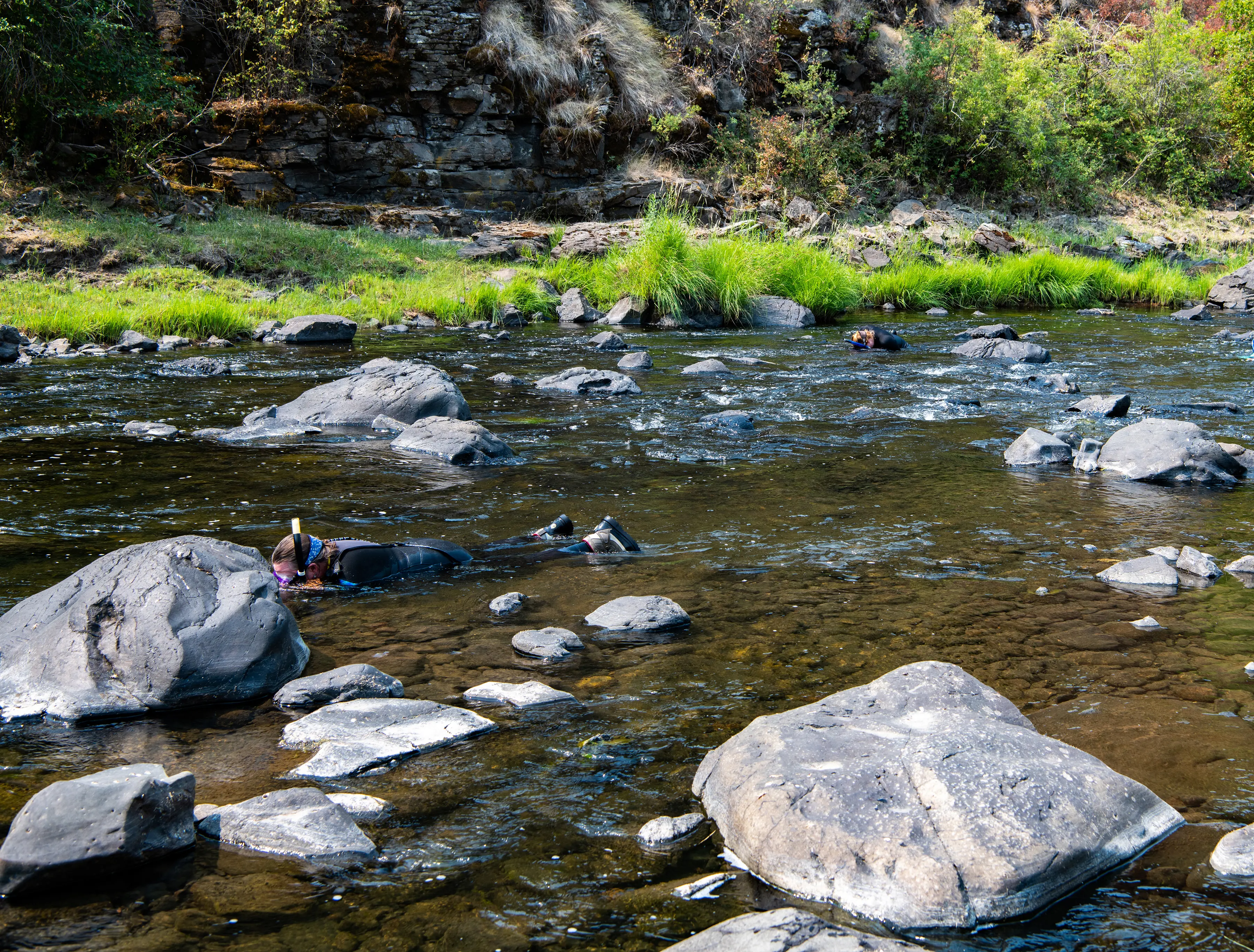
“This is our mother, as if we drew our living from her,” Cayuse Chief Stikus at the Walla Walla Council is quoted in As Days Go By, Our History, Our Land, Our People. The Cayuse, Umatilla, and Walla Walla.
It’s mid-July, and the Pacific Northwest is experiencing an historic heat wave of such proportions that scientists conclude it to be ‘virtually impossible’ without human-caused climate change. In the hot and dry air, with the temperature exceeding 100 degrees Fahrenheit, scientists Alexa Maine and Christine O’Brien don full-length wet suits, masks, and snorkels. They lower themselves into the crystal-clear waters of the John Day River’s upper reaches in eastern Oregon.
The water is too shallow for swimming, so Maine and O’Brien gently float upstream, pulling themselves along over rocks and gravel, being careful not to stir up bottom sediments that would impede visibility.
As they inch their way along, they are scanning the river bottom for one of the most endangered animals in North America. Freshwater mussels, historically a key part of riverine ecosystems and food source for Indigenous peoples, have been on the decline nationwide for several reasons, many of which began with colonization by European settlers.
The Xerces Society for Invertebrate Conservation notes that, while the range of these animals in the west extended from northern Mexico to Alaska and from the Pacific Coast inland to Wyoming, Montana, and Arizona, research suggests they have disappeared from nearly one-fifth of the watersheds where they were once found.
It is difficult to pinpoint the cause of species decline in specific cases, but many modern era alterations to the natural landscape are implicated. Climate change influences water quantity and temperature, dams and other projects affect habitat and life cycle, and urbanization and farming practices change stream flow and affect water quality; all these modern era changes affect the ability of this sensitive species to survive.
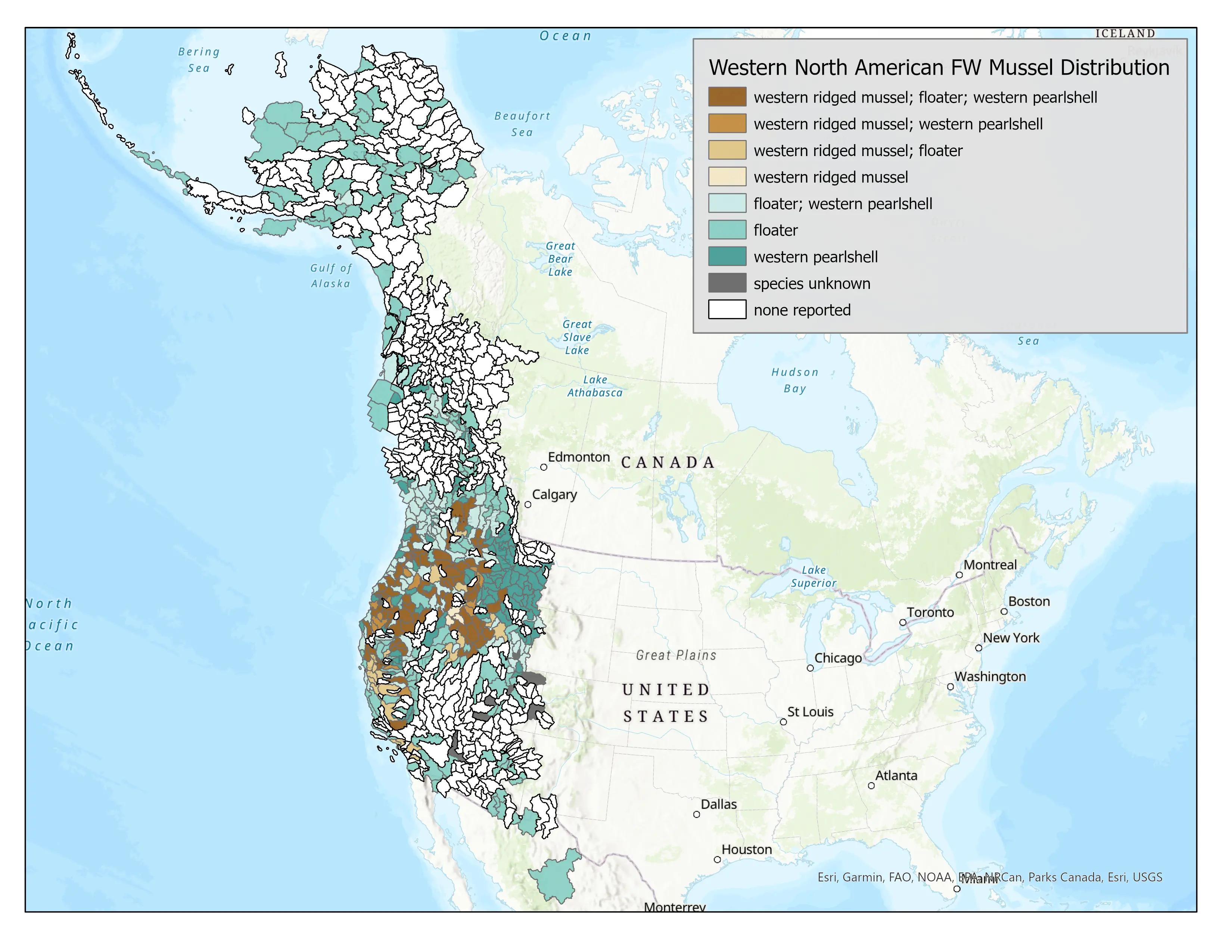
CTUIR leads the way in the West
The Confederated Tribes of the Umatilla Indian Reservation—made up of the Cayuse, Walla Walla, and Umatilla tribes—are leading the way in efforts to study and promote conservation of freshwater mussels in the West. The tribes’ mussel work is focused primarily in five river sub-basins: the Walla Walla, the Umatilla, the Grand Ronde, the Tucannon, and the John Day.
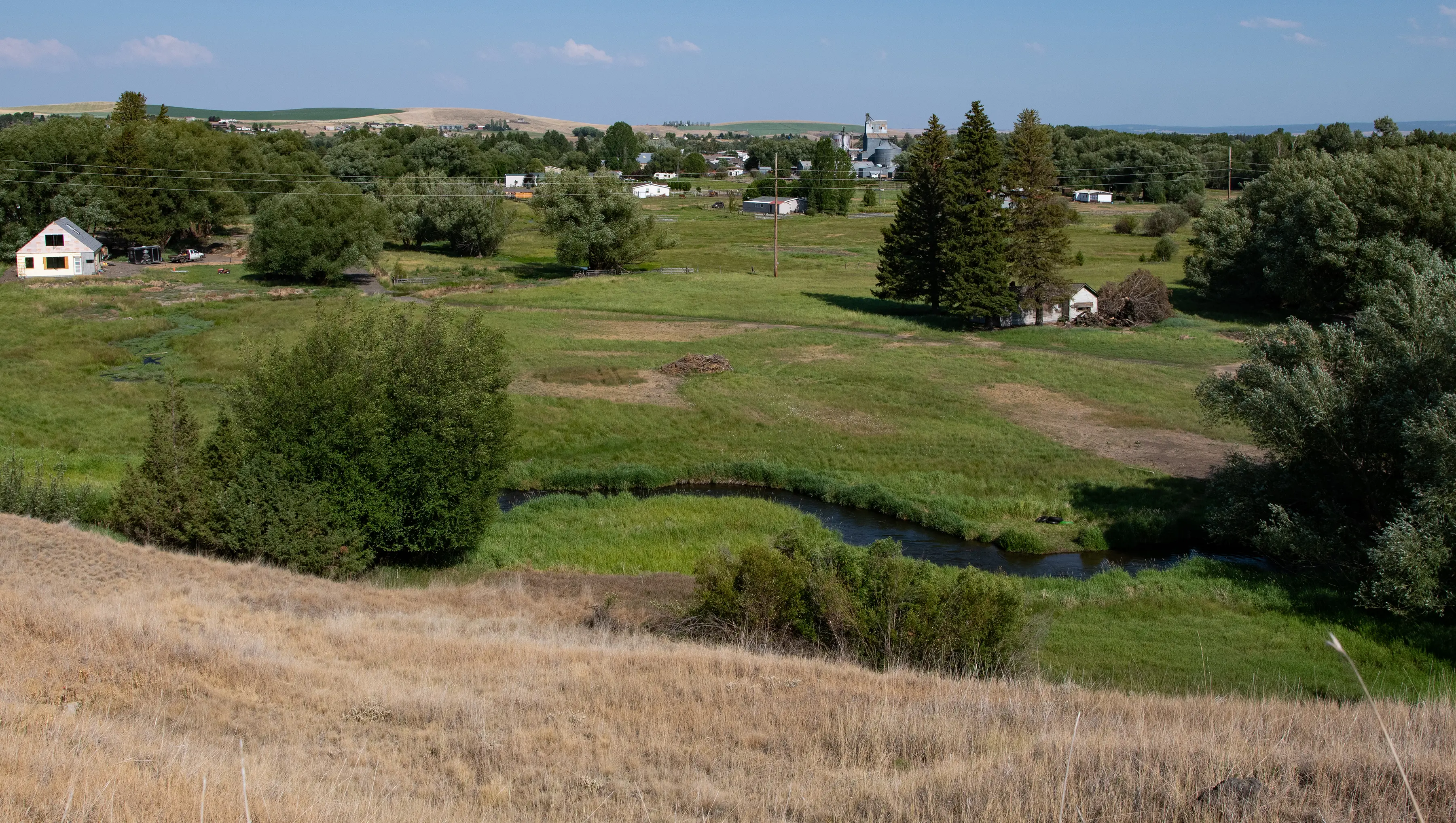
Maine is an employee of the CTUIR, and O’Brien is a CTUIR contractor who has spent nearly 30 years studying freshwater mussels. Maine notes the CTUIR is the only agency with full-time staff dedicated to research and restoration of mussels. In addition to Maine and O’Brien, Donna Nez is a tribal member and a freshwater mussel technician who has worked for the CTUIR since 2000. Nez is involved in field work and research and was instrumental in producing an educational book about freshwater mussels.
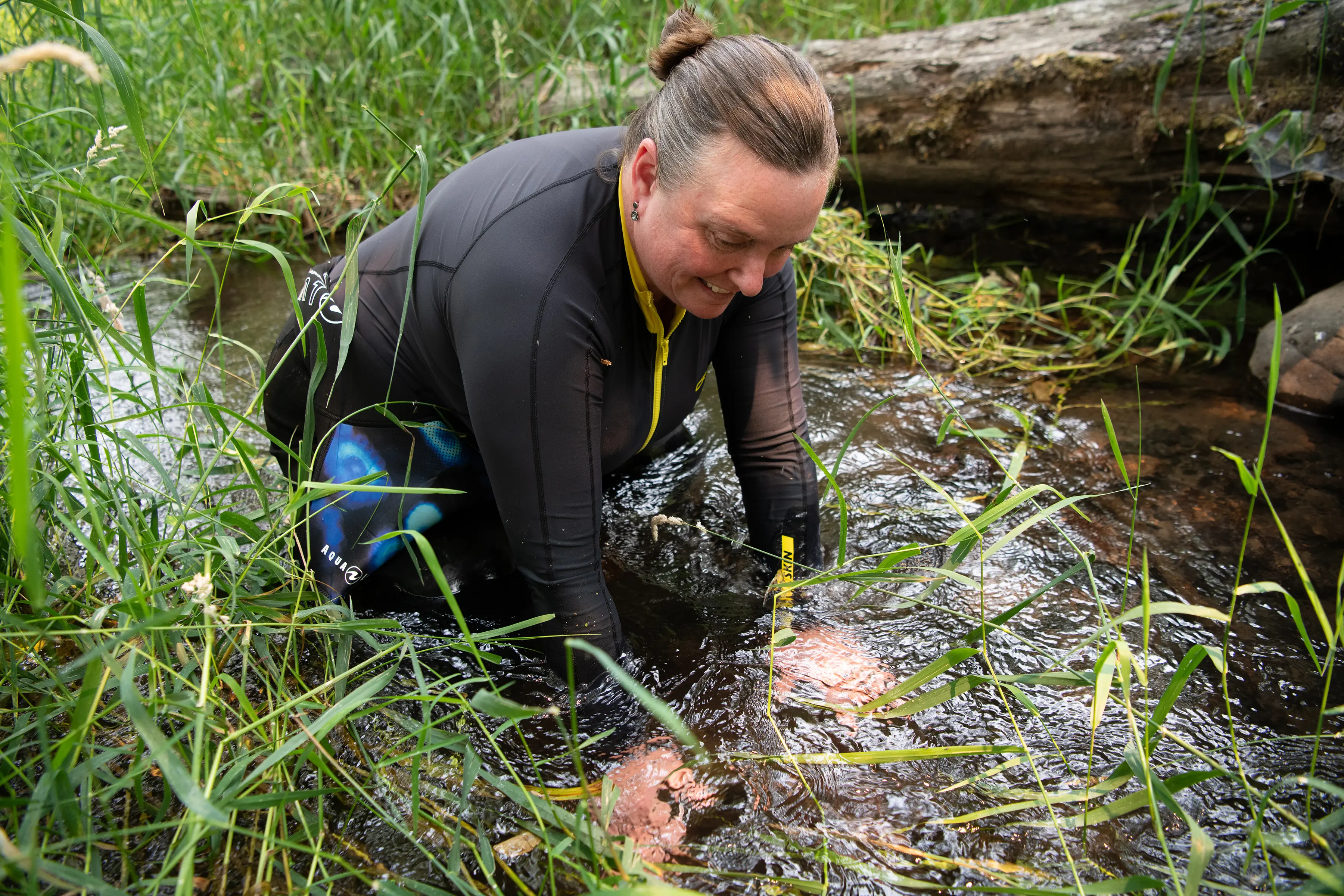
The CTUIR are federally-recognized and governed by a Board of Trustees, and as such are viewed by the U.S. Government as a “distinct, independent political community.” CTUIR natural resource management activities are carried out by their Department of Natural Resources.
“All of that research for all of the mussels in the West has come out of CTUIR,” said Maine. She further notes CTUIR’s ability and resources to undertake these efforts is due in part to their status as a recognized tribe. “But that doesn't mean that CTUIR is more important than [other tribes that have not been given] federal status for whatever reason, and therefore don't have the infrastructure [of the] CTUIR. Their first foods are the same and their needs are the same, even though they don't have the same…funding opportunities.”
Maine laments the relative inattention to western species when compared to the greater number of scientists working with freshwater mussels in other areas of the country. She notes that, although a handful of people have come on board, the funding is still very limited.
Despite the somewhat lackluster efforts to date, Maine is encouraged by the steady increase in federal and state agencies’ interest in western freshwater mussels she has seen during her tenure with the tribe, which began as a volunteer in 2011 and an employee in 2013.
For example, Maine is working with the Bureau of Land Management and the Forest Service to put together a survey protocol so these agencies can begin documenting freshwater mussels. She notes a large percentage of the West has not been surveyed for mussels, which is a significant problem.
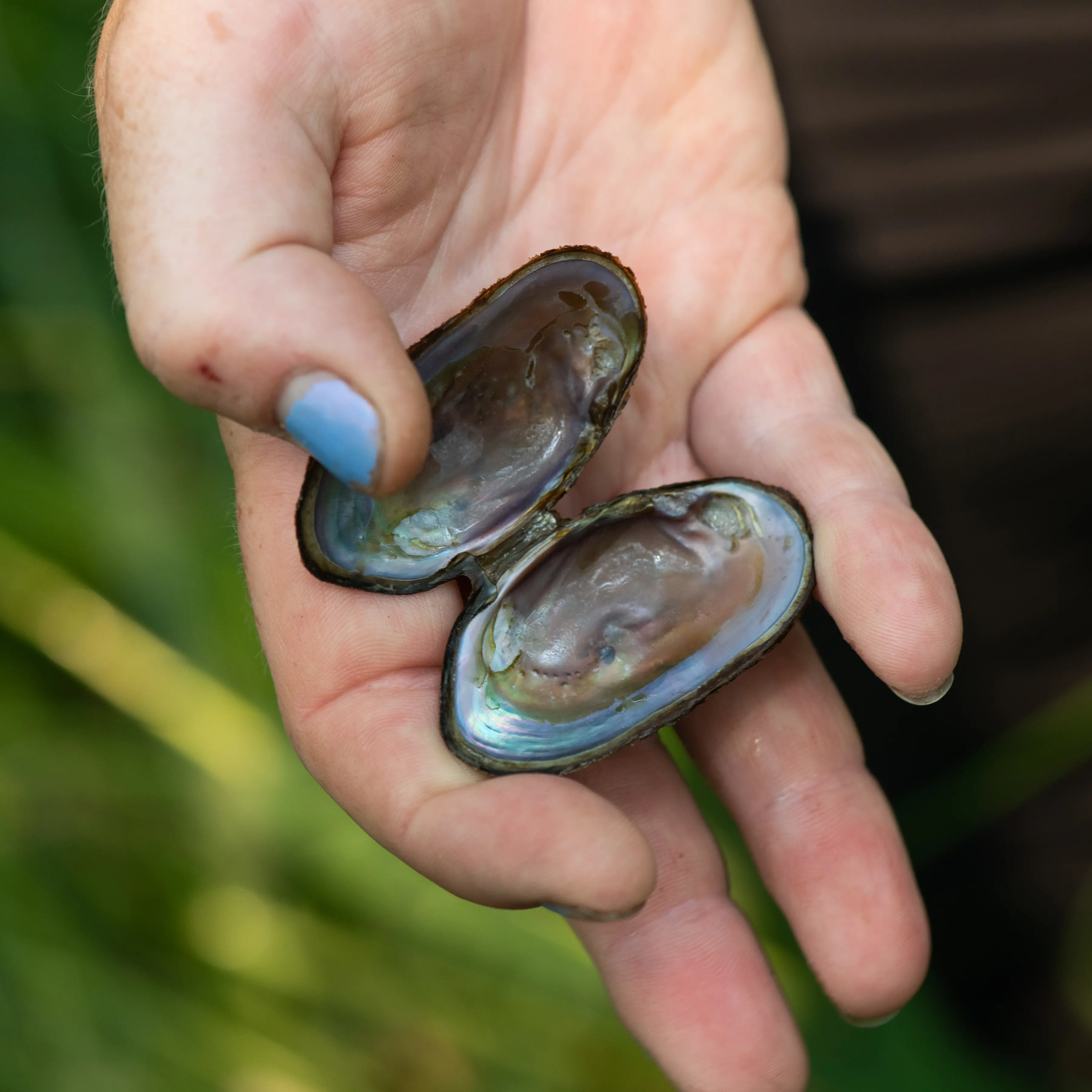
A key part of the tribes’ work is to help correct this deficiency of data with respect to the presence and diversity of species. The CTUIR is working with the Portland-based Xerces Society to document populations.
“The database that CTUIR created and co-manages with Xerces Society is a huge resource,” said Maine. “Now we have a central place for people [to record mussel discoveries]. [This work] led to a paper in 2017 that looked at the extinction risk of our species in the West, [which] kind of helped jump start some of the state agencies to start looking at mussels a little bit more closely.” It also provided a foundation to petition the U.S. Department of Interior to list the Western Ridged Mussel, Gonidea angulata, as an endangered species.
The CTUIR Department of Natural Resources has been documenting populations for the last two decades. They are finalizing a master plan which calls for artificially producing mussels and supplementing various life stages throughout tribal ceded lands in northeast Oregon and southeast Washington. The eventual goal is to restore sustained natural mussel populations. This unique effort has never been tried before and is expected to take many decades.
A First Foods approach
This work is formulated around the tribes First Foods philosophy for natural resource management, which is articulated in the CTUIR’s publication The Umatilla River Vision. This document was first released in 2008 and updated by CTUIR department of natural resource director Eric Quaempts in 2011. The framework established by this document “seeks to reflect the unique tribal values associated with natural resources and to emphasize ecological processes and services that are undervalued by westernized Euro-American natural resource strategies.”
The vision, developed by CTUIR for the Umatilla River basin but more broadly applicable to resource management, is for a “healthy river capable of providing First Foods that sustain the continuity of the Tribe’s culture.”
“This is where I think CTUIR has a really good stance, this River Vision,” said Maine. The vision views everything as connected “so that the restoration is a full, holistic restoration of the entire river system so that it can provide First Foods… That’s unique to the CTUIR.”
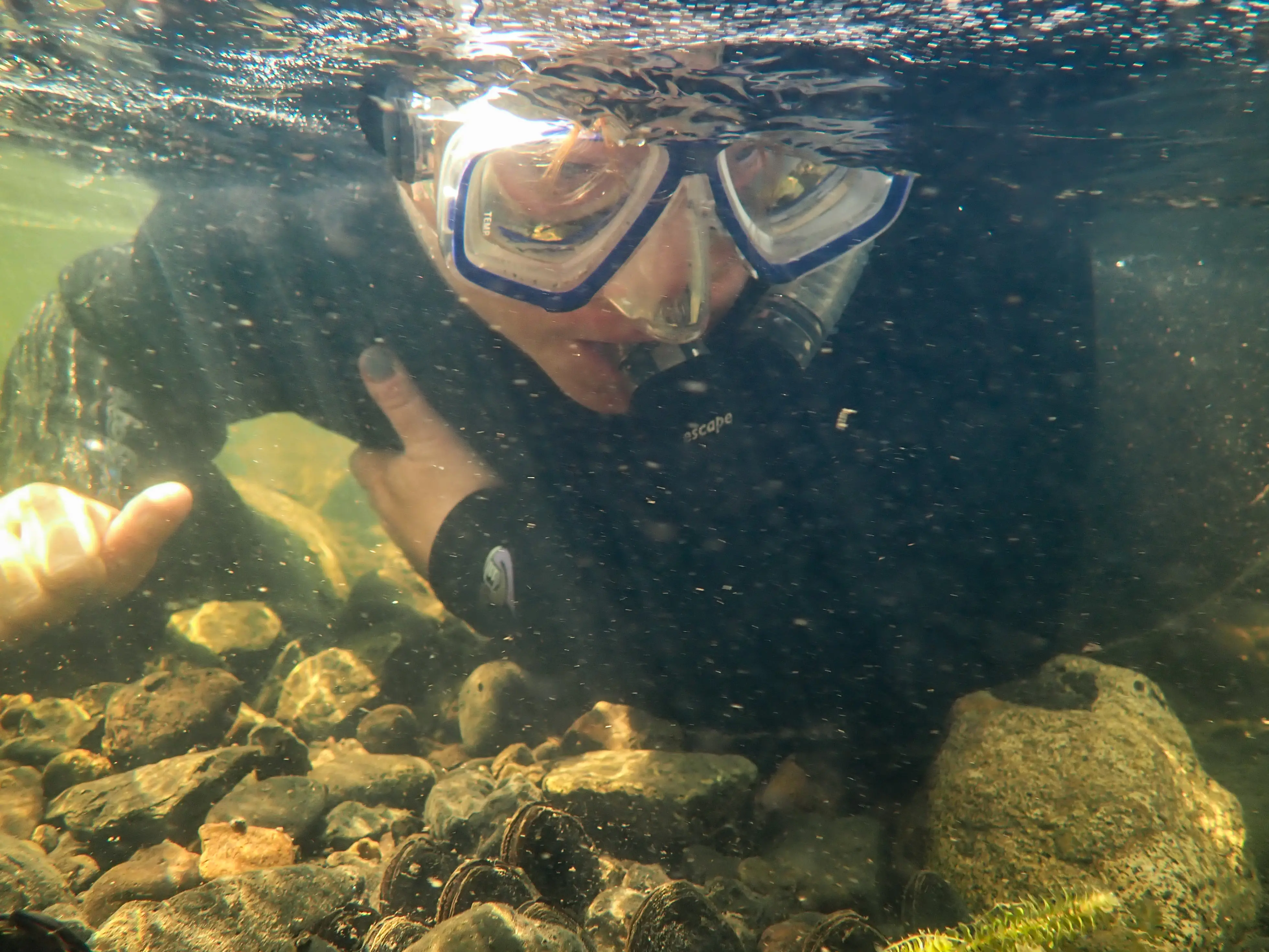
Cultural traditions
The Plateau Indians have lived in the Pacific Northwest for 10,000 years. The traditional use areas of the Walla Walla, Cayuse, and Umatilla are concentrated most heavily in Eastern Oregon and Washington but encompass a large swath of territory reaching north to Canada, west to the coast, south to California and Nevada, and east to Wyoming and Montana.
The tribes moved around these areas in seasonal cycles to harvest the food sources that sustained them. The traditional gathering of roots and berries, fishing for salmon, collecting other aquatic species, and hunting game are an important aspect of tribal culture.
In 1855, the three tribes signed a treaty whereby the U.S. government distributed 6.4 million acres of tribal lands, known as the ceded territories, to mostly Euro-American settlers. As noted in in The Umatilla River Vision, this action resulted in a shift in land utilization philosophy from the tribal ways of communal and sustainable use of resources to one of extraction of resources for private use, resulting in profound impacts to the tribal way of life.
The Umatilla Indian Reservation is approximately 172,000 acres and is located east of Pendleton, Oregon. Under the Treaty of 1855, the tribes retained rights for hunting and gathering in their traditional use areas to engage in the cultural practices they have maintained for thousands of years. A primary goal of the First Foods approach is to restore the resources and make it feasible for tribal members to exercise these treaty rights.
The Creation story
Wenix Red Elk is the public outreach and education specialist for the CTUIR Department of Natural Resources, Cultural Resources Protection Program. Working with the department and the tribe, Red Elk oversees service learning in colleges and does public education in grade school through college. Much of her work revolves around salmon restoration and promoting the First Foods management approach.
Red Elk explains that the idea of First Foods is connected to the tribes’ Creation story, whereby, starting with the salmon, the animals and plants gave of themselves to the people as sources of food, clothing, and tools in exchange for the care and protection by the people; in other words, a relationship of reciprocal care.
The order in which the animals and plants offered themselves to the people informs the order in which courses are served in a traditional meal. The meal begins and ends with a drink of water in recognition of the fact that it is water that sustains all life.
“When we’re talking about the water and the foods and the relationship…our first law always goes back to that traditional teaching,” said Red Elk. “From the time that we’re little, when we’re sitting in the house, you hear the adults talking about foods…’we’re going to go out and we’re going to go root digging at this time’ or ‘we’re going to go fishing at this time’… so you hear your parents are talking about the importance of food [in ceremonies and feasts].”
The specific practices for obtaining these traditional foods are passed down through generations and are based on methods to ensure the collection is conducted in a responsible and sustainable manner. This includes minimizing waste and using all parts of what is harvested. With respect to mussels, this means eating the meat and using the shells to craft tools and beads.
“We are a food-associated culture,” said Red Elk. “Every Native song that we have, the religious practice, everything we do relates back to the Creation and when those foods came forward and when we promised ourselves with them.”
Due to the decline of Western freshwater mussel species, Red Elk notes it has been generations since tribal members have been able to collect mussels for their traditional uses. The shell necklaces in existence today are those made by earlier artisans, crafted when freshwater mussels were still abundant, and passed down through the generations as prized heirlooms.
No small task
Restoration of freshwater mussels is complicated by their complex life cycle. The male releases sperm into the water, which is siphoned up by the female to fertilize her eggs and then transformed into larvae known as glochidia. The female releases the microscopic glochidia into the water, where they attach to the gills or fins of a host fish to mature into juveniles before dropping off to begin life as an independent organism at the bottom of the stream. Different species of mussels require different species of host fish.
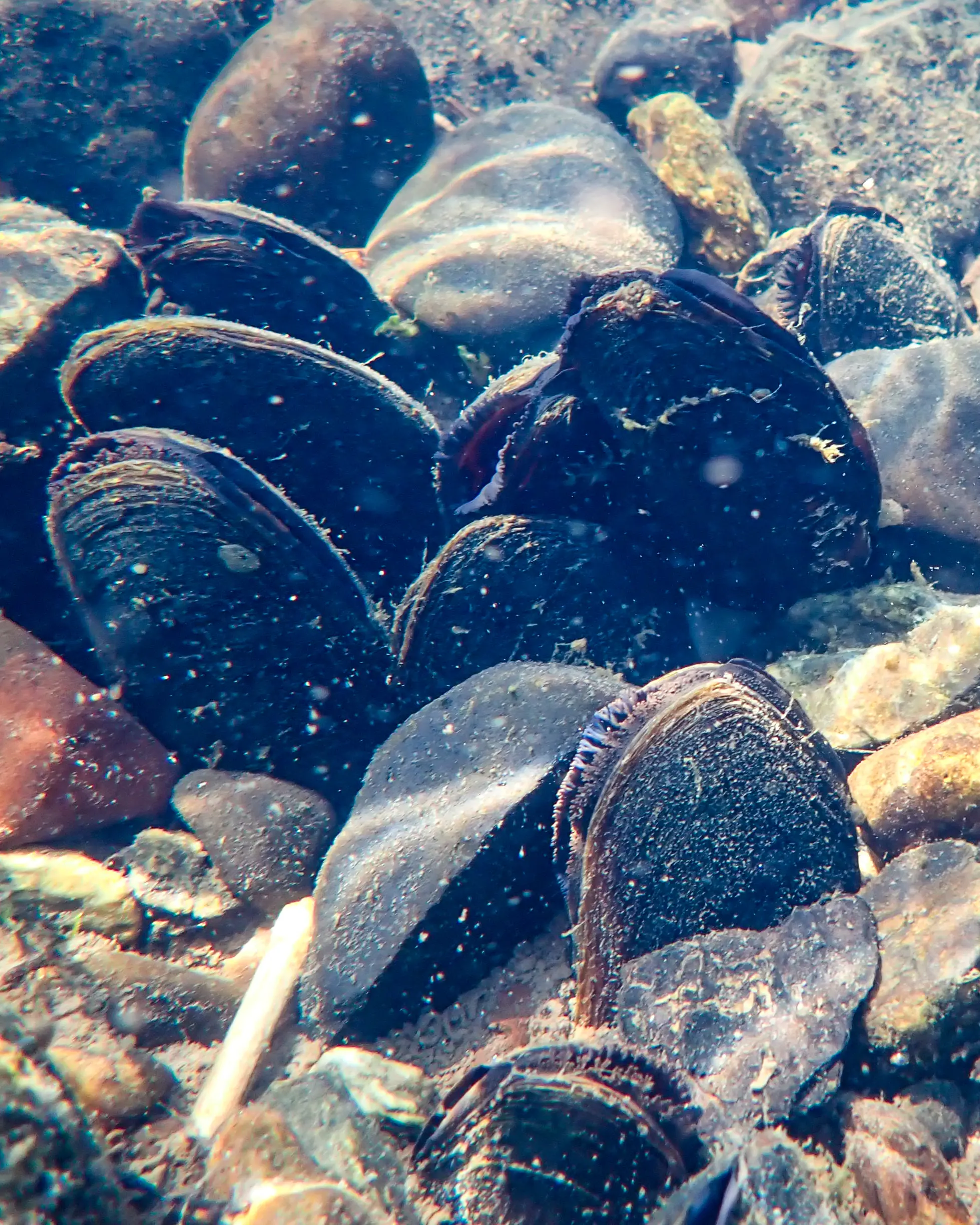
A freshwater mussel burrows into a streambed with a pseudopod, a portion of its body it extends like a foot outside of its shell. From the other end, the mussel extends a siphon to draw in water to filter feed; relying on water flowing over them to bring the nutrients to sustain them. Mussels remain largely stationary for their entire life.
Mussels filter as much as 10 to 15 gallons of water per day. In the process, they clean the water like a vertebrate animal’s liver cleans its blood—which is how they have earned the nickname “liver of the river.” This particular “ecosystem service” freshwater mussels perform also makes them especially sensitive to increased sediment or toxic chemicals in the water.
Because they are sedentary filter feeders, they require a stable stream channel and flowing water, meaning any geomorphologic changes to the stream can also affect their viability. Climate change and stream channel alterations can cause impacts not only to mussels, but also their host fish, which are sensitive to water temperature changes, stream flow declines caused by drought, and other stream disruptions. The numerous variables at play for freshwater mussels to survive and reproduce make restoration particularly challenging.
Declining numbers
Many freshwater mussel species have already been declared extinct. The West has fewer species than other parts of North America, but some of the species have historically had a very large range. For example, Maine notes the range of the Western Pearlshell, Margaritifera falcata, is from northern Alaska to southern California. They can form dense beds of hundreds of thousands, if not millions, of mussels and live 80 to 100 years.
But this longevity can also lead to misinterpretations of the health of mussel populations by those who do not understand the life cycle of the mussel. “You can look at a Margaritifera bed and say, ‘oh there’s hundreds of thousands of them, they look fine,” said Maine. “But if you look closer there is not a single individual under the age of 50… So for 50 years, …there has been no reproduction.” She adds, “Those are going to die someday, and then there’s nothing left.”
O’Brien points to several factors that have led to the decline of freshwater mussels, including water pollution, changes in water temperature and drying up of streams, and unnatural stream channelization from farming practices and urbanization, which in turn leads to increased erosion and sedimentation.
Climate change impacts represent a relatively recent phenomenon. “In the past 20 years, I'm thinking that global warming is also now rearing its ugly head,” said O’Brien. She notes the freshwater mussels are very sensitive to water temperature changes, especially during breeding season.
“It’s just death by a thousand cuts for mussels,” said O’Brien. “It’s…this really broad issue that people are trying to figure out.” To further compound the problem, O’Brien notes there is potentially a novel virus affecting some species of mussels, but scientists still lack a complete understanding of this problem.
Building a program
Gary James was the first biologist hired by the CTUIR in 1982 to manage the fisheries program. After 39 years, he now oversees a staff of 70 people.
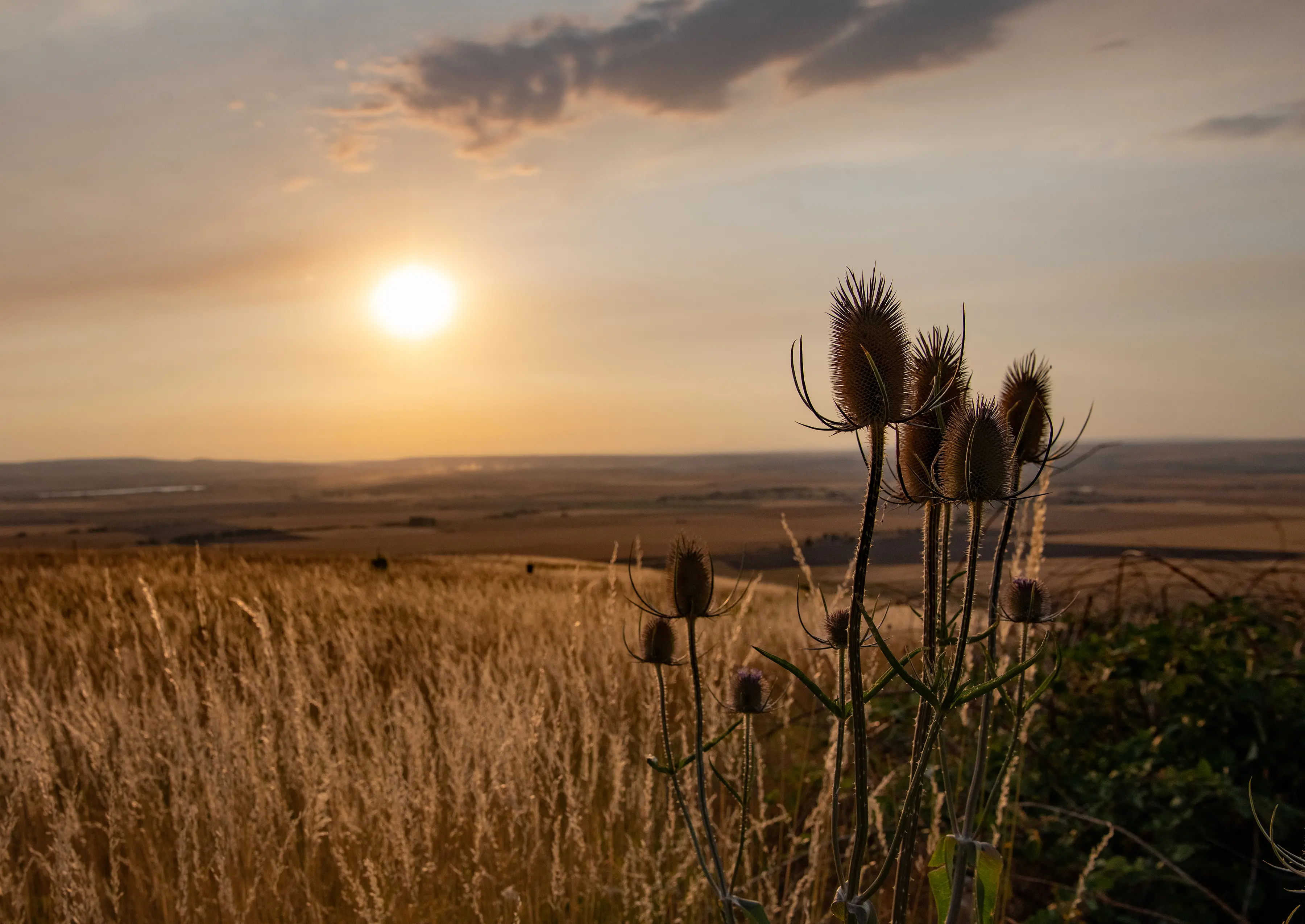
James reflects on the challenges of working with aquatic species in eastern and central Oregon. “I looked at those rivers. And there was not only no salmon, but there was no water at key times a year,” said James. “I thought, hey, why would I want to work here? But there's always been a positive side and then I looked at it as so much to be gained.”
Congress enacted the Northwest Power Act of 1980, which created a partnership between the Bonneville Power Administration (BPA) and federal and state agencies. This included a requirement for BPA to provide funding to mitigate natural resource impacts from a series of hydroelectric dams in the Columbia River system. James notes these funds have “been the lifeblood of building [the CTUIR’s] program.”
Although James is not himself a tribal member, he is a true believer in the tribal way of approaching natural resource management in a holistic fashion, as evidenced by his long tenure with CTUIR. “It all connects to our First Foods/River Vision and mission,” said James. “It’s so deeply ingrained in the culture and science both… It’s very powerful.”
“I think we’ve had some good results,” said James. “We’ve got a good relationship with Bonneville Power. It’s kind of win-win. We’re restoring aquatic First Foods and habitat, which addresses their mitigation requirements while creating opportunities to exercise a treaty fishing rights for CTUIR.”
Emilie Blevins works with the Xerces Society on freshwater mussel research, policy, and advocacy. She is passionate about helping what she terms the more “unloved” species.
“We’re dealing with such a complex species but also complex environment with so many things out of our control,” said Blevins. “This year, we are in a historic drought. The effects of that on the mussel population are devastating.”
Blevins echoes the concerns of other scientists when she notes the problems are not confined to drought, but also declines in water quality, habitat degradation, water use, and declines in host fish populations.

Aside from working toward restoration, Blevins notes the importance of monitoring existing populations. “One of the main challenges facing mussel populations in the western U.S. right now are these mass mortality events [where] we don’t really know the causes,” said Blevins. The ability to document such events was only possible because CTUIR and Xerces had collected data and documented the presences of mussel beds prior to the die off.
“Having [this] kind of approach to doing research and conservation, where you have these sites that are sort of sentinels to help us understand what’s happening [is] so critical because some things are happening on a very short time scale,” said Blevins. This helps justify work on the longer time scale. “That mussel bed is not going to come back in two years; it’s not like a wildflower meadow that you can re-seed.”
“In the Northwest, tribes have had this incredible effort to force important change in the natural resources world,” said Blevins. “Tribes advocating for salmon and lamprey and mussels have all resulted in the state and federal government having to take notice and do the right thing.”
Blevins stresses the importance of the tribe’s work and long-term commitments to conservation efforts for freshwater mussels. “You have to agree to be in it for the long haul… [CTUIR has] really led the way and it’s made space for other people to follow suit. It is really inspiring.”














